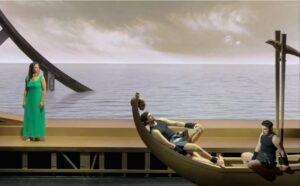
Teatro La Fenice 2024 Review: Maria Egiziaca
By João Marcos CopertinoPhoto: Roberto Moro
Sometimes, opera programming can be extremely original, providing us with unexpected titles. That was the case with La Fenice/Maria Malibran’s “Maria Egiziaca,” Otto Respighi’s eclectic and sensuous opera. Especially when hearing lesser-performed titles, it is very hard to define what to expect musically. While in classic and baroque operas, there is a certain inner grammar of the music that makes everything easier (the aria and recitative format); in modernist titles, anything can happen. Respighi might not be the most modernist composer, but his craft clearly interconnects with trends of modernism. Watching his “Maria Egiziaca” can be a tantalizing exercise in trying to place what music school his music would best fit. Sometimes the music seems impressionist; other times, there are true allusions to baroque opera. My personal recommendation is to keep your ears open to the heterodox nature of the piece. In a certain way, the musical wanderings of the piece are kind of a 1930s hallucination of what music might be.
In a certain way, “Maria Egiziaca” seems to be a patchwork of musical and dramaturgical references. The story of a luxurious prostitute transformed into a saint is not unfamiliar, especially in the context of the turn of the twentieth century. La Fenice’s production explored as much as it could the contraposition of sacred symbolism and female sensuality. Pier Luigi Pizzi’s understanding of sensuality is static and sculptural. The singers’ and dancers’ beautiful bodies are exposed as if they were long-lost statues from Olympia. Such images are emphasized by the pale light palette by Fabio Barettin and the hideous CGI images by Pizzi. More than anything else, the aim was to explore this aesthetic ideal of the body as a Venus or Doryphoros; to this end, dancer Maria Novella Della Martira, as Maria’s double, was a good addition to the opera.
Again, the CGI images were very distracting. They worked better as abstractions than symbols. Clouds and seas are better projected than Palaces, crosses, and rings. Nevertheless, the cast did interact with the images in a proper manner. But it is interesting to note that the most provocative moment of the opera, a luxurious dance of devotion over a Catholic cross, worked much better with the cross there, and not projected.
The musical miscellany of the night overflowed from the singers’ lines. In many ways, it was amazing to see an opera that seemed a vocal crossroads of singing techniques. Soprano Francesca Dotto showcased an impressive versatility and physical ability in the title role of the opera. The lyric voice, with tight vibrato, brought a sense of visceral and musical urgency to a production marked by symbolism. The role does not present much of a psychological progression; it presents three different moments in the life of Maria. Dotto, wisely, created a connection between the three moments by emphasizing Maria’s overt personality. I was left with the impression that nothing was hidden, and everything spelled out to the last syllable. Even in the third act, when Maria is old and repentant, it is not hard to connect the aged woman that we see with the vamp from the first scene. There is an inability to mask anything. In her over-exposition of the character, we were charmed by beautiful phrasing, especially when she moved towards extremely crystalline piano sounds.
Baritone Simone Alberghini sings the Peregrin/Abbot with a certain parsimony that is sometimes moving, and at other times underwhelming. While his attention to phrasing and intonation with the orchestra is commendable, his voice is a bit less opulent than the rest of the cast. Therefore, we see a religious figure who lacks that looming aspect usually associated with comparable operatic roles. There is no Grand Inquisitor here, only a lyric character disguised as a monk. The conversion of Maria becomes even more genuine when compared to the fragility of her religious peers. She converted because of the cross, not because of any evangelizer.
Tenor Vincenzo Costanzo, as the sailor, is the perfect incarnation of the Italian lyric tenor in the space of the opera. His participation, restricted to the first thirty minutes of the opera, was extremely impressive. Costanzo has that tenor quality of extremely dramatic gaps, especially in the break of his voice—like most tenors who sing verismo repertoire. The effect was sublime, a very verismo voice singing along with an orchestra that seemed sometimes to be Debussy, other times baroque revival.
In general, the vocal richness of the night was possible only because of these three soloists and the good work from the chorus off-stage. Michele Galbiati, Luigi Morassi, Ilaria Vanacore, and William Corrò were scenically and musically perfect in their minor parts, exuding a sense of youthfulness in the staging that was much welcomed.
The La Fenice Orchestra played well under the direction of Manlio Benzi. Given the heterogeneity of the orchestra, it seemed to me that he managed well such a difficult sonic universe. Nevertheless, regardless of how musically interesting Respighi’s works can be, I was not fully convinced of “Maria Egiziaca’s” greatness. I am tempted to believe that, but for its performers’ goodwill, this short opera (of roughly an hour) would make a very forgettable night. Still, better to run the risk of original and ambitious opera programming than to consign audiences to the same titles night after night.


